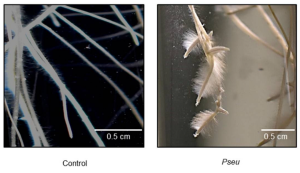A group from UMR IPSiM, Université de Montpellier, Institut Agro, CNRS, Montpellier, France, etc. has reported about two diazotrophic PGPR strains, isolated from the rhizosphere of a wild wheat ancestor as beneficial bacteria.
https://www.ncbi.nlm.nih.gov/pmc/articles/PMC9740669/
Two bacterial strains, Pseudomonas BPMP-PU-28 and Enterobacter BPMP-EL-40, were isolated from the rhizosphere of a wild wheat ancestor. These strains have been shown to stimulate plant growth when the availability of nitrogen in the soil is limiting for the growth.
A striking effect of culture supernatant obtained from these beneficial bacteria was observed on root hair density and length in root apical regions as shown below (left-hand side is a control and right-hand side shows that of Pseudomonas).
The following features were seen in exudates from these bacteria.
The AHL N-tetradecenoyl-L-homoserine lactone (TDHL) has been found in BPMP-PU-28 and BPMP-EL-40 exudates. AHLs play a role in bacterial quorum sensing and in bacterial communication networks. They have positive effects on plant growth, and could be recognized by plant receptors and lead to modifications of plant gene expression.
It should also be noted that while no amino acids were detected in the bacterial exudates, some cyclopeptides were present. Together with AHLs, cyclic peptides have been shown to play a role in quorum sensing. In addition to playing a role in quorum sensing, cyclic peptides can act as mimetics of phytohormones which upregulate salicylic acid, ethylene and jasmonic acid signaling.
In addition to AHLs and cyclopeptides, many of the metabolites identified in exudates may play a role in plant growth promotion, for example by behaving as antibiotics (about 18% of the identified metabolites can be expected to have antibiotic effects), or by improving nutrient ion acquisition.

